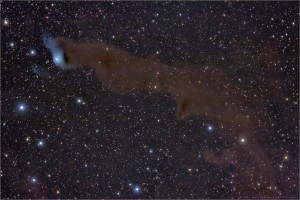VdB 152 in Cepheus
Copyright 2011 Jerry Lodriguss / AstroPix.com
Van den Bergh 152, also known as Cederblad 201, is a blue reflection nebula at top left in the image. The large dark nebula stretching through the frame is Barnard 175, a Bok Globule. This complex, also called Wolf’s Cave, is located about 1,400 light years away in the direction of the constellation of Cepheus.
Full of very faint dust, this area is part of a large molecular cloud named the Cepheus Flare by Edwin Hubble. The opaque dust blocks most of the starlight behind it, but blue light from a young star is scattered and reflected off some of the particles to illuminate the reflection part of the nebula. Some of the faint dust may be glowing in a dim red color from luminescence, forming an Extended Red Emission nebula (ERE).
The 9.3 magnitude star B.D. +69° 1231, inside vdB 152, seems to be powering the nebulae in the area, but is not thought to have formed there, but rather is just passing through.
Wolf’s Cave was first discovered photographically by August Kopff, an assistant to Max Wolf, and announced by Wolf in 1908 in the Monthly Notices of the Royal Astronomical Society, Vol. 69, p.117.
The van den Bergh catalog was published by Sidney van den Bergh in 1966 from a study of the Palomar Sky Survey and contains 158 reflection nebulae.
Barnard 175 was cataloged by E. E. Barnard in A Photographic Atlas of Selected Areas of the Milky Way from photographs made at Lick Observatory from 1889-1895, but not printed until 1913.
North is to the right in this image.
